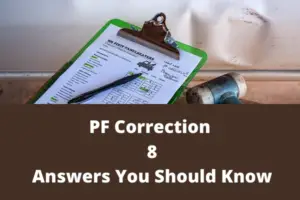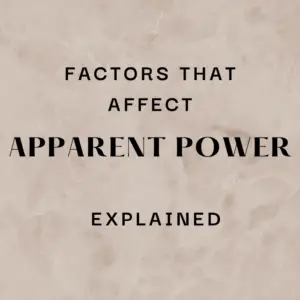Voltage regulation and voltage drop are two important concepts in electrical engineering. They are closely related, but they have different meanings and applications.
In this article, we will discuss the difference between voltage drop and voltage regulation in detail.
Table of Contents
What is Voltage Drop?
Voltage drop is the amount of voltage that is lost or dropped as electric current flows through a conductor, such as a wire or a cable.
Voltage drop occurs due to the resistance of the conductor, which impedes the flow of current and results in a loss of voltage.
The amount of voltage drop depends on the length and cross-sectional area of the conductor, as well as its material and temperature.
Voltage drop is an important factor to consider in electrical circuit design and installation, as it can affect the performance of the circuit and the equipment it powers.
Excessive voltage drop can lead to voltage fluctuations, power losses, and overheating of the equipment.
Therefore, it is important to calculate the voltage drop of a circuit and ensure that it is within acceptable limits.
The formula for calculating voltage drop is:
Discover the Secrets to Accurate Voltage Drop Calculations: Unlock the Power of Your Electrical System with My In-Depth Guide Article Here!
VD = IR
Where VD is the voltage drop, I is the current flowing through the conductor, and R is the resistance of the conductor.
For example, if a 10 A current flows through a 50 m long copper wire with a cross-sectional area of 1 mm², the resistance of the wire can be calculated as:
R = ρL/A
Where ρ is the resistivity of copper (1.68 x 10⁻⁸ Ωm), L is the length of the wire (50 m), and A is the cross-sectional area of the wire (1 mm² = 1 x 10⁻⁶ m²).
R = (1.68 x 10⁻⁸ Ωm x 50 m) / (1 x 10⁻⁶ m²) = 0.84 Ω
Using the formula VD = IR, the voltage drop can be calculated as:
VD = 10 A x 0.84 Ω = 8.4 V
Therefore, the voltage drop in the wire is 8.4 V, which is significant for a circuit with a low voltage supply.
What is Voltage Regulation?
Voltage regulation is the ability of a power supply to maintain a constant output voltage under varying load conditions.
Voltage regulation is important in applications where a stable and precise voltage is required, such as in electronic devices and industrial equipment.
A power supply with good voltage regulation will maintain a constant output voltage despite changes in the input voltage, load current, and temperature.
The voltage regulation of a power supply is usually expressed as a percentage of the output voltage deviation from the nominal voltage, under specified load and input conditions.
The formula for calculating voltage regulation is:
VR = (Vno – Vfl) / Vno x 100%
Where VR is the voltage regulation, Vno is the nominal output voltage, and Vfl is the full-load output voltage.
For example, if a power supply has a nominal output voltage of 12 V and a full-load output voltage of 11.8 V, the voltage regulation can be calculated as:
VR = (12 V – 11.8 V) / 12 V x 100% = 1.67%
Therefore, the voltage regulation of the power supply is 1.67%, which is a good value for most applications.
Difference Between Voltage Drop and Voltage Regulation
Voltage drop and voltage regulation are two different concepts, but they are related in the sense that they both involve voltage variations in an electrical system.
The main difference between voltage drop and voltage regulation is:
- Voltage drop is the loss of voltage that occurs due to the resistance of a conductor, whereas voltage regulation is the ability of a power supply to maintain a constant output voltage under varying load conditions.
- Voltage drop is a function of the resistance of the conductor and the current flowing through it, while voltage regulation is a function of the power supply’s design and its ability to compensate for changes in load and input conditions.
- Voltage drop is a concern in electrical circuits and installations, as it can affect the performance of the circuit and the equipment it powers. On the other hand, voltage regulation is a concern in power supply design, as it can affect the stability and reliability of the power supply’s output voltage.
- Voltage drop is expressed in volts, while voltage regulation is expressed as a percentage of the output voltage deviation from the nominal voltage.
- Voltage drop can be calculated using the formula VD = IR, while voltage regulation can be calculated using the formula VR = (Vno – Vfl) / Vno x 100%.
Conclusion
Voltage drop and voltage regulation are two important concepts in electrical engineering that involve voltage variations in an electrical system.
While voltage drop refers to the loss of voltage that occurs due to the resistance of a conductor, voltage regulation refers to the ability of a power supply to maintain a constant output voltage under varying load conditions.
Both concepts are important to consider in electrical circuit design and power supply design, respectively and can affect the performance and reliability of the equipment they power.
Don’t Leave Empty-Handed!
Install my Free Android App on Google Play:
Electrical Cables Most Common Tables “Cables Tables”
And, my Electrical Calculations App “Fast Electrical Calculator”
Discover more great content by subscribing to My channel
Looking to stay ahead of the game in the world of electrical engineering? Subscribe to my YouTube channel and gain access to exclusive content you won’t find anywhere else!
The staff I recommend
(Amazon Affiliate Links to products I believe are high quality):
- Economy 120 Volt/60Hz AC Power Source – Step-Down Voltage & Frequency Converters 1800W
- UNI-T Digital Multimeter Tester UT139C
- 50-Amp Extension Cord for RV “100ft”
- Voltage Stabilizer 110/220v
- Hair Dryer “best selling“
- TOSHIBA EM131A5C-BS Countertop Microwave Ovens
Disclaimer: This contains affiliate links to Amazon products. I may earn a commission for purchases made through these links.


